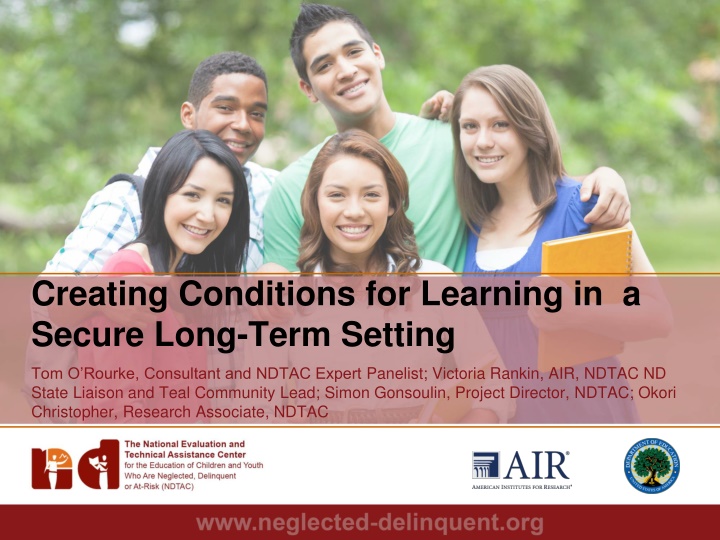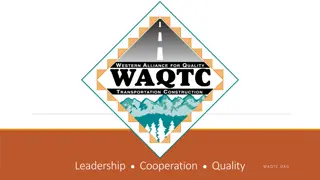
Enhancing Learning Conditions in Secure Settings
Explore behavior and mental health issues impacting learning conditions, adolescent brain research findings, and critical pillars for effective learning environments in secure long-term settings. Understand the importance of safety, support, social-emotional learning, and engagement for learners.
Download Presentation

Please find below an Image/Link to download the presentation.
The content on the website is provided AS IS for your information and personal use only. It may not be sold, licensed, or shared on other websites without obtaining consent from the author. If you encounter any issues during the download, it is possible that the publisher has removed the file from their server.
You are allowed to download the files provided on this website for personal or commercial use, subject to the condition that they are used lawfully. All files are the property of their respective owners.
The content on the website is provided AS IS for your information and personal use only. It may not be sold, licensed, or shared on other websites without obtaining consent from the author.
E N D
Presentation Transcript
Creating Conditions for Learning in a Secure Long-Term Setting Tom O Rourke, Consultant and NDTAC Expert Panelist; Victoria Rankin, AIR, NDTAC ND State Liaison and Teal Community Lead; Simon Gonsoulin, Project Director, NDTAC; Okori Christopher, Research Associate, NDTAC 1
Behavior/Mental Health Issues That May Impact Efforts To Address Conditions for Learning Rate of E/BD six times that of regular school-age population (Gagnon & Barber, 2010) Deficits in interpersonal problem solving and capacity for self-regulation (Gagnon & Richards, 2008) Greater risk for antisocial and aggressive tendencies (Connor, 2002) Typical MH Diagnosis: conduct disorder, substance abuse disorders, oppositional defiant disorder , ADHD, anxiety and depression, higher rates of cognitive disabilities girls extremely high rates of PTSD (Teplin et al., 2002) 2
Adolescent Brain Research Maturation continues well into a person s early 20s (Luna, 2005) Prefrontal cortex, which governs the executive functions, is the final area of the human brain to mature (Thompson, 2004) Dopamine is not yet at its most effective level in adolescence (Spear, 2003) 3
Adolescent Brain Research (cont.) Engage in activities of greater risk and higher stimulation in efforts to achieve similar levels of excitement Rely heavily on the parts of the brain that house the emotional centers when making decisions Spear, 2003 4
Improving Conditions for Learners Who Are N and D Learning is both a cognitive and social and emotional process relationships, relationships, relationships School climate Supports needed to provide teachers and staff Osher, Sidana, & Kelly, 2008 5
Critical Pillars of Effective Conditions for Learning Safety-Learners must be, and feel, safe Support-Learners must feel connected to teachers and the learning setting Social and Emotional Learning (SEL)-Learners need to learn to manage their emotions and relationships Engagement and Challenge-Learners youth need to be actively engaged in learning endeavors Osher, Sidana, & Kelly, 2008 6
Critical Pillars of Effective Conditions for Learning (cont.) Social and Emotional Learning (SEL) Learners need to learn to manage their emotions and relationships positively and be surrounded by peers who also have socially responsible behavior Engagement and Challenge Learners need to be actively engaged in learning endeavors that are relevant to them and enable them to develop the skills and capacities to reach positive life goals Osher, Sidana, & Kelly, 2008 7
Safety Issues Physical and emotional harm perceived levels of risk for harm/violence Core psychological need 8
Safety Research Basic psychological needs addressed and met Students may align with and commit to the school s norms and rules Unsafe school environments may result in negative risk-taking behaviors and disengagement from school Osher et al., 2008 9
Safety Measures Pledge for Safety Campaign for staff and youth inclusive of school environment Developed 5 year strategic plan first initiative is Safety First! Checklist of examples of ways to improve safety in facility school 10
Support Connection and attachment to the adult in the facility school---caring relationships and respectful treatment Strength based programming Individualized peer influence 11
Support Research High-quality supportive relationship with an adult may have dramatic effects on student s performance and well-being Lack of teacher connections a predictor of poor academic performance and problem social behavior High-quality relationships with their students yield 31 % fewer discipline problems 12
Support Cross departmental collaboration, mentoring type programs; school based counseling both individual and group; evidence based programming; medication feedback effort; positive rewards not always negative consequences Individualized approaches when students were not being successful in school multiple supports/services such as functional SBLC and Individual Learning Plans 13
Support Family/Youth Ombudsman position to address concerns of youth and family Engaged parents/family in school activities (orientation CD, IEP meetings, events, open house, mailed report cards home every grading period, parent/teacher teleconference, student involvement in decision making) 14
Social Emotional Learning Learning to understand and manage their emotions and relationships Demonstrate care and concern for others, establish positive relationships and handle challenging situations in nonviolent, mature and reasoned ways Foundation for academic achievement, good physical and mental health, citizenship and productive employment 15
Social Emotional Research Contributes to ability to respond to academic frustrations, inappropriate behavior, and anti social peer behavior improve attitudes toward school, provide academic motivation and higher aspirations Better understanding of the consequences of behavior, provide coping skills for school stressors which result in fewer conflict situations and fewer suspensions Performance improvements include better grades, being on track to graduate, fewer dropouts Osher et al., 2008 16
Social Emotional Learning Consistent behavioral management and self control programming is effective in reducing drop out rates, conduct problems and substance abuse AEPM Skills necessary for high school graduates & workforce relate to SEL: self esteem, sociability, integrity/honesty problem solving, self management, responsibility, listening, and decision-making Training for Educational Staff and Leadership: focus is on skill development for staff Student Support Teams: individual approaches Service learning: opportunities to practice skills Osher et al., 2008 17
Engagement and Challenge Energizing a student s interest in the educational process Multidimensional: academic, behavioral, cognitive and psychological Enhanced when it builds upon a student's strengths, addresses their interests, provides them with a light at the end of the tunnel Challenge with high expectations, must be personally motivated and feel the school is connected to larger life goals: Think Exit at Entry 18
Engagement and Challenge Research School to work linkages show an inverse correlation between vocational and employability skills and recidivism Better outcomes are achieved when creative and exciting learning environments are fostered and established that are tailored to students interests Osher et al., 2008 19
Engagement and Challenge CAPS curriculum alignment with state standards, individualized, mastery learning, records management Adequate space, staffing, instructional supplies /materials, technology, library services, instructional support services Full-continuum of educational services, special education, counseling, testing, vocational training, school to work projects 20
YDC Student Transition Model Think Exit at Entry 21
Activity and Q&A Safety, Support, Social Emotional Learning, and Engagement and Challenge Small-group work Challenges in facility schools to address four pillars found in NDTAC s Condition for Learning document Accept the challenge! 23
References Connor, D. F. (2002). Aggressive and antisocial behaviors in children and adolescents. Research and Treatment. New York, NY: Guilford. Gagnon, J. C., & Barber, B. R. (2010). Characteristics of and services provided to youth in secure care facilities. Behavioral Disorders, 36, 7 19. Gagnon, J. C., & Richards, C. (2008). Making the right turn: A guide about youth involved in the juvenile corrections system (pp. 1 61). Washington, DC: National Collaborative on Workforce and Disability for Youth, Institute for Educational Leadership. Luna, B. (2005). Brain and cognitive processes underlying cognitive control of behavior in adolescence. University of Pittsburgh. 24
References Osher, D., Sidana, A., & Kelly, P. (2008). Improving conditions for learning for youth who are neglected or delinquent. Washington, DC: National Evaluation and Technical Assistance Center for the Education of Children and Youth Who Are Neglected, Delinquent, or At-Risk (NDTAC). Retrieved from http://www.neglected- delinquent.org/nd/resources/spotlight/cflbrief200803.asp Spear, L. P. (2003). Neurodevelopment during adolescence. Neurodevelopmental Mechanisms in Psychopathology. Cambridge University Press. Teplin, L. A., Abram, K. M,. McClelland, G. M, Dulcan, M. J, & Mericle, A. A. (2002). Psychiatirc disorders in youth in juvenile detention. Archives of General Psychiatry, 59, 113 143. 25
References Thompson, P. (2004). Time-lapse imaging tracks brain maturation from ages 5 to 20. National Institutes of Mental Health and UCLA. 26




















